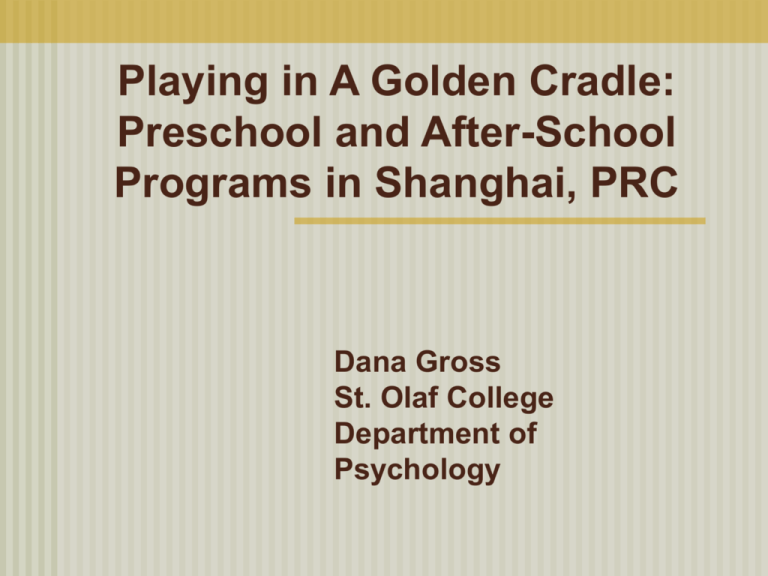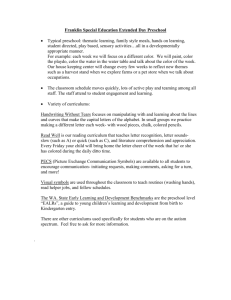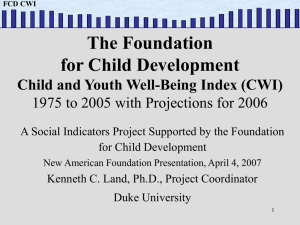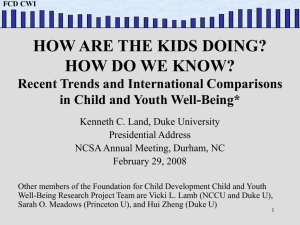Playing in A Golden Cradle
advertisement

Playing in A Golden Cradle: Preschool and After-School Programs in Shanghai, PRC Dana Gross St. Olaf College Department of Psychology A “Golden” Childhood China’s past, present, and future Preschools in China The Shanghai Children’s Palace Childhood in China Population of approximately 1.31 billion (UNICEF, 2006) 60% to 70% live in rural areas 10% to 12% are children younger than 5 years Fertility rates declined from 5.9 in 1970 to 1.7 in 2004 (Hesketh, Lu, & Xing, 2005) One-child policy (1979) changed family structure and interactions: the 4-2-1 syndrome Grandparents provide care for many infants and children younger than 3 China’s Past, Present, and Future Reform and “opening up” policies were introduced in 1978 Growing prosperity has resulted Per capita income has increased from $280 in 1985 to $1290 in 2005 (World Bank, 2006) Health indicators reflect the impact of these trends: malnutrition and mortality rates among infants and children under 5 have declined, while immunization rates have increased Education Reform in China Elementary school enrollment is reported to be 99%, whereas in 1949 only 20% of children were in school Preschool guidelines and training were established in the 1950s but most preschools were closed during the Cultural Revolution (1966-1976) (Tobin, Wu, & Davidson, 1989) Approximately 70% of all children receive at least one year of preschool education (Xuezhong, 2000) Types of preschools today include full-day, half-day, and boarding programs What do we know about childhood in China? Chinese children draw well because they are taught how to draw (Winner, 1989): “Chinese children do not draw childish drawings.” “Chinese children behave very differently from American children, not only in art class but in most other situations as well.” “Classes are very ‘teacher centered.’” Chinese parents socialize their children from an early age to think in Confucian ways about learning, obligation, and relationships (Chao, 1994; Miller, Wiley, Fung, & Liang, 1997; Stevenson, Chen & Lee, 1993; Wu, 1996) Chiao shun ~ training Guan ~ to govern, love, care for Preschool in Three Cultures showed that many preschools in China endorse traditional beliefs and practices but that parents and teachers are concerned about “spoiling” (Tobin, Wu, & Davidson, 1989) Tai jao ~ too delicate, fussy, spoiled Regional Differences China’s urban children outperform their rural counterparts in physical, cognitive, and social development (Xie & Young, 1999) Urban parents are more likely than rural parents to believe that early stimulation and education are beneficial and necessary Urban parents tend to enroll their children in preschool at an earlier age than rural parents Preschool quality tends to be higher in urban than rural settings: facilities, resources, training, compensation Preschool at East China Normal University Children ages 3 to 6 years Tuition is 320 rmb/month (approx. $40) In materials, structure, curriculum, and atmosphere, there was little resemblance to the “Dong Feng” preschool (Tobin et al., 1989) The CWI Children’s Palace The first after-school activity center in China Established in 1953 by Song Qingling (aka Soong Ching-ling, Sung Ch’ing-ling, and Madame Sun Yat-sen) Song Qingling (1892-1981) One of three daughters in the powerful Song family “The one who loved China” (Seagrave, 1985) Educated at Wesleyan College for Women in Macon, Georgia (Class of 1913) “Children can not just enjoy their childhood’s happiness in the Children’s Palace. It is more important for them to learn the capability of laboring alongside with learning to do profitable things for the collective, motherland, and wellbeing of the people!” Song Qingling, 1958 The Children’s Palace Today Tuition is 200-300 rmb for 3 months of classes (approx. $25-$38) Classes are offered M-F 5:00-6:30 and all day on Saturdays Approximately 7,000 children (4-16 years) took classes at the Children’s Palace in Shanghai in 2004 Classes in dance, music, art, theater, and science teach skills, build confidence, and stimulate curiosity and exploration (Yang Zhi Ying, 2005, personal communication) The Children’s Palace is a “paradise for children and also a base for cultivating versatile persons.” Interest groups and classes reflect children’s interests and have been designed in accordance with Song Qingling’s “Children’s Educational Thoughts” and with developmentally appropriate practices. (A Brief Introduction of China Welfare Institute Children’s Palace, 2003) Other CWI Institutions The CWI International Peace Maternity and Child Health Hospital The CWI Nursery The CWI Kindergarten Soong Ching Ling Children Development Center The CWI Children’s Art Theatre The CWI Nursery Established in 1950 by Song Qingling. A boarding and day-care preschool education unit for children ages 2-6. Promotes the “development of children’s health physically and mentally.” Integrates health care with education “in order to make scientific arrangements for the daily life of children.” The CWI Kindergarten Educational objectives specify that children should be: Healthy and confident Polite and able to communicate Curious and like to explore Independent and cooperative The Soong Ching Ling Children Development Center Gathers data and conducts research about children from birth to age 16. Publishes “Preschool Education Information and Research.” Trains preschool teachers. QuickTime™ and a TIFF (LZW) decompressor are needed to see this picture. QuickTime™ and a TIFF (LZW) decompressor are needed to see this picture. QuickTime™ and a TIFF (LZW) decompressor are needed to see this picture. “Arduously Cultivating a New Innovative and Exploring Generation for the 21st Century” -Inscription from Jiang Zemin What will happen to the golden cradle as China continues to grow and expand? Individual -- group orientation Creativity -- regimentation (Arnett, 2002; Chen, Cen, Li, & He, 2005; Fuligni & Zhang, 2004; Swartz,1989) Acknowledgements The Freeman Foundation Asian Studies Department, St. Olaf College East China Normal University CWI Children’s Palace References Arnett, J.J. (2002). The psychology of globalization. American Psychologist, 57, 774-783. Chang, J., & Halliday, J. (1986). Madame Sun Yat-Sen: Soong ChingLing. London: Penguin. Chao, R.K. (1994). Beyond parental control and authoritarian parenting style: Understanding Chinese parenting through the cultural notion of training. Child Development, 65, 1111-1119. Chen, X., Cen, G., Li, D., & He, Y. (2005). Social functioning and adjustment in Chinese children: The imprint of historical time. Child Development, 76, 182-195. Fuligni, A.J., & Zhang, W. (2004). Attitudes toward family obligation among adolescents in contemporary urban and rural China. Child Development, 74, 180-192. Hesketh, T., Lu, L., & Xing, Z.W. (2005). The effect of China’s onechild family policy after 25 years. New England Journal of Medicine, 353, 1171-1176. Miller, P. J., Wiley, A. R., Fung, H., & Liang, C. (1997). Personal storytelling as a medium of socialization in Chinese and American families. Child Development, 68, 557-568. References (continued) Roopnarine, J.L., & Metindogan, A. (2006). Early childhood education research in cross-national perspective. In B. Spodek, & O. Saracho (Eds.), Handbook of research on the education of young children (2nd ed., pp. 555-571). Mahwah, NJ: Lawrence Erlbaum Associates Publishers. Seagrave, S. (1985). The Soong dynasty. New York: Harper & Row. Stevenson, H. W., Chen, C., & Lee, S. (1993). Mathematics achievement of Chinese, Japanese, and American children: Ten years later. Science, 259, 53-58. Swartz, L.M. (1989). “Raising the cultural level” at the Hangzhou Children’s Palace. Journal of Aesthetic Education, 23, 125139. Tobin, J.J., Wu, D.Y.H., & Davidson, D.H. (1989). Preschool in three cultures: Japan, China, and the United States. New Haven, CT: Yale University Press. References (continued) UNICEF. (2006). The official summary of The State of the World’s Children 2006. New York: Author. Winner, E. (1989). How can Chinese children draw so well? Journal of Aesthetic Education, 23. Wu, D.Y.H. (1996). Chinese childhood socialization. In M.H. Bond (Ed.), The handbook of Chinese psychology (pp. 143-154). Hong Kong: Oxford University Press. Xie, Q., & Young, M.E. (1999). Integrated child development in rural China. Washington, DC: The World Bank. Xuezhong,Z, (2000). Education for all: The year 2000 assessment final country report of China. New York: UNESCO World Education Forum.







